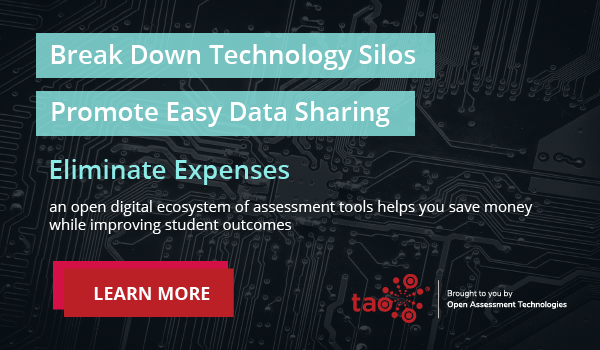Remote learning means remote testing, and for many institutions, this digital transition marks uncharted territory. In today’s global climate, there is no denying the need for digital assessment technology to continuously reach students — even when they can’t be in the classroom — and provide lifelong learning support. But, as the world is accelerated into eLearning and institutions are bringing their assessments online for the first time, they are faced with a number of new considerations.
So how can your institution find an effective path from paper-and-pencil to online assessment? Considerations must extend from the type of tests and content you create, to the technical aspects of customization, configuration, integration, test security, and just as important, support.
Integration with Systems and Content
Consider the systems you have in place; if your institution is just starting to adopt eLearning, you may not have many (or any) other systems that you need to integrate with. On the other hand, you could have complex legacy technology in place that needs to work holistically with any new assessment platform introduced to the stack. In either case, interoperability is a key feature to look for when migrating to a digital testing solution.
If you are building your eLearning ecosystem from the ground up, interoperable systems that are built on QTI open standards and leverage LTI capabilities allow for smoother integration with myriad applications as you grow your suite of solutions. An open digital assessment platform also integrates much more easily with legacy EdTech systems you might have, which can come with their own set of complexities. Enabling smooth integration through open standards ultimately means you spend less time, money and resources trying to connect your technology solutions.
Working within an open QTI certified assessment environment also lets you maximize the value of the content you create. Building your content on QTI standards ensures that your assets, items and tests are completely transferable to other vendors. Platforms that support LTI (Learner Tool Interoperability) allow for launching and communication between educational platforms.
Many proprietary systems lock content away, making it incompatible or difficult to integrate with other systems. With open assessment software, this is not the case. An assessment platform that leverages open standards provides you with the peace of mind that your work can move with you, even if you need to switch systems.
Translating Paper-based Test Items to Digital
Even more important than the technical integration is your testing content and how you can effectively translate your questions from paper to digital. What type of tests and questions are you creating? What do you need to measure? Different types of assessments require different features and interactions, so these are just some considerations to keep in mind when making the transition to digital assessment.
For instance, some paper-based test items, like multiple choice, can easily translate to a digital platform. However, for multi-step problems, the transition may not be so straightforward. If you’re trying to measure 21st century problem solving skills using modern testing techniques, your platform needs to support more complex custom technology enhanced items (TEIs) and portable custom interactions (PCIs).
How do you define TEIs vs PCIs? Take a look at our infographic Building Engaging Online Assessments with Technology Enhanced Items for a deeper understanding.
Ease of Use & Adoptability
While digital assessment technology is complex in its own right, the user interface for your online testing platform should be clear, streamlined and easy to use to support the transition to digital. An intuitive design can make a tremendous difference in efficiency for both test authors and test creators who need to learn the system quickly. Growing pains are to be expected when migrating from paper and pencil to digital assessment, but highly adoptable platforms that highlight usability and accessibility will mitigate these challenges. If you don’t think your system would need much custom functionality you may want to look into a turn-key platform to launch your testing program.
Your digital testing solution should also be accessible, adhering to the latest WCAG standards to provide better access to both test authors and test candidates. Our accessibility series covers a variety of posts on the topic as it relates to usability, including removing barriers to digital assessment, and the importance of usability for creating and taking tests.
Indeed, some large scale programs have moved gradually into full digital testing by starting with students with accessibility needs first. This allows you to start at a significantly smaller scale, and tackle some of the logistical problems of access from the beginning. By the time you ramp up to large-scale delivery, everyone can access their tests – there’s no waiting until next year for the people that need the most help.
Support
The technology is only half of the equation when it comes to a successful transition from paper-based-testing to digital assessment. Institutions also need the support of a team dedicated to run, manage and upkeep a new testing platform. This includes everything from managing cloud hosting to account support to ensure your program runs smoothly. If you don’t have an internal team to tackle this and keep track of milestones, support from your assessment software partner will be critical — especially during your campaign windows. So as you’re considering investing in different digital testing systems, consider what kind of support you might need as well.
Pro tip: When you are first migrating from paper to digital assessment, dedicated account management can make sure you are staying on track with your campaign goals and help with any hiccups along the way.
Flexibility to Evolve: Open Source
“Will the testing solution evolve with the needs of the institution and today’s learners?” Though it may be difficult to predict what features and functionalities you’ll need down the line, you want your solution to be able to scale.
Many of today’s largest world leading educational institutions consider open source as a driving factor in selecting EdTech software. An open source digital testing platform allows you to access and extend the source code with your own unique functionality. Open source also empowers collaboration within a community of users.
—
The transition from paper-and-pencil to digital testing comes with unique challenges and considerations. Taking a step back, finding a technology partner and analyzing your needs will help you take the first steps toward going digital.

